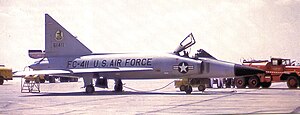Perrin Air Force Base
| Perrin Air Force Base | |
|---|---|
| Part of Air Training Command (ATC) Air Defense Command |
|
| Located near: Sherman, Texas | |

4780th Air Defense Wing Convair F-102A-75-CO Delta Dagger 56-1411
|
|
| Coordinates | 33°42′47.92″N 96°40′25.61″W / 33.7133111°N 96.6737806°W |
| Type | Air Force Base |
| Site information | |
| Controlled by | United States Air Force |
| Site history | |
| Built | 1941 |
| In use | Open 1941 - closed 1971 |
| Airfield information | |||||||||||||||
|---|---|---|---|---|---|---|---|---|---|---|---|---|---|---|---|
| Summary | |||||||||||||||
| Elevation AMSL | 749 ft / 228 m | ||||||||||||||
| Coordinates | 33°42′51″N 096°40′25″W / 33.71417°N 96.67361°WCoordinates: 33°42′51″N 096°40′25″W / 33.71417°N 96.67361°W | ||||||||||||||
| Map | |||||||||||||||
| Location of Perrin Air Force Base | |||||||||||||||
| Runways | |||||||||||||||
|
|||||||||||||||
Perrin Air Force Base is an inactive United States Air Force base, approximately 7 miles northwest of Sherman, Texas. It was active during World War II as pilot training airfield and during the Cold War as a combat crew and flying training base. It was closed on 30 June 1971.
After seeing the fighters take off from the base, a young Chesley Sullenberger became interested in flying.
Perrin Air Force Base began as an army air field and was the first basic flying training school to become operational after the Japanese attack on Pearl Harbor on 7 December 1941.
In the spring of 1941, Grayson County leaders began to discuss the possibilities of a U.S. Army Air Corps basic flying school to be built in Grayson County. In March 1941 Grayson County Judge Jake J. Loy went to Washington, DC, to further the project idea. After his visit to Washington, Judge Loy returned to Sherman and began to work on the project with county commissioners, and a tract of land was subsequently selected that was suitable for use as a flying field.
On 16 June 1941, the Office of the Chief of the Air Corps drew up a program for construction. A tentative authorized strength of 199 officers, 422 cadets, 1730 enlisted men, and funds in the amount of $3,966,833.00 were ordered and set aside for the construction of the airfield. The lease was signed by the United States Government and Grayson County on 1 July 1941 and the Army Corps of Engineers started construction on the newly established Grayson Basic Flying School the same week.
On 9 August 1941, Major Robert J. Warren was the first person to report to duty at the partially constructed airfield, assuming duties as project officer and temporary commanding officer. Ten days later, five enlisted men arrived from San Angelo, TX, to assist Major Warren in the development of the airstrip, hangars, barracks, and field headquarters building.
The airfield was laid out with four runways in a triangle pattern, consisting of 4500x150(N/S), 2700x150(NE/SW), 4200x150(E/W), 5137x150(NW/SE), all constructed of concrete. A large parking apron was constructed to accommodate the planned basic (phase II) training aircraft with at least 6 maintenance hangars and supporting buildings. East of the airfield, a ground support station was constructed consisting of about several hundred buildings based on standardized plans and architectural drawings. The buildings were designed to be the "cheapest, temporary character with structural stability only sufficient to meet the needs of the service which the structure is intended to fulfill during the period of its contemplated war use." To conserve critical materials, most facilities were constructed of wood, concrete, brick, gypsum board and concrete asbestos. Metal was sparsely used. Perrin Field was designed to be nearly self-sufficient, with not only hangars, but barracks, warehouses, hospitals, dental clinics, dining halls, and maintenance shops were needed. There were libraries, social clubs for both the officers and enlisted men, and stores.
...
Wikipedia



